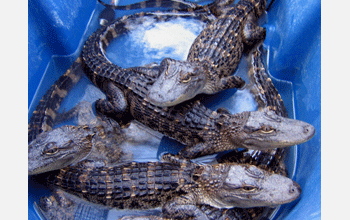Multimedia Gallery
Alligator Muscles Move Lungs (Image 2)
Alligator Muscles Move Lungs (Image 2)
Scientists have long believed that American alligators like these evolved certain muscles to help them breathe. But a new University of Utah study suggests that the muscles first evolved so alligators could move their lungs around inside their bodies, using the lungs as floatation airbags to help them dive, roll sideways and otherwise maneuver despite a lack of fins or flippers.
The study was conducted by C. G. Farmer, assistant professor of biology at the University of Utah, and T. J. Uriona, a doctoral student in biology. They discovered gators maneuver silently by using their diaphragm, pelvic, abdominal and rib muscles to shift their lungs like internal floatation devices: toward the tail when they dive, toward the head when they surface and sideways when they roll. In this manner, they can navigate their watery environment without creating a lot of disturbance when they are trying to sneak up on their prey.
The discovery in American alligators suggests "special muscles that manipulate the position of the lungs--and thus the center of buoyancy--may be an underappreciated but important means for other aquatic animals to maneuver in water without actively swimming," says Farmer. Those animals include crocodiles, African clawed frogs, some salamanders, turtles and manatees.
The study by Farmer and Uriona, which was funded by the National Science Foundation (under grant IBN 01-37988, awarded to C.G. Farmer), the University of Utah and a private donor, Sharon Meyers of California, was published in the April 2008 issue of The Journal of Experimental Biology. To read more about the study, see the University of Utah news story, "How Alligators Rock and Roll." (Date of Image: March 2008) [See related image Here.]
Credit: Hannah Chirillo, University of Utah
Images and other media in the National Science Foundation Multimedia Gallery are available for use in print and electronic material by NSF employees, members of the media, university staff, teachers and the general public. All media in the gallery are intended for personal, educational and nonprofit/non-commercial use only.
Images credited to the National Science Foundation, a federal agency, are in the public domain. The images were created by employees of the United States Government as part of their official duties or prepared by contractors as "works for hire" for NSF. You may freely use NSF-credited images and, at your discretion, credit NSF with a "Courtesy: National Science Foundation" notation.
Additional information about general usage can be found in Conditions.
Also Available:
Download the high-resolution JPG version of the image. (2.1 MB)
Use your mouse to right-click (Mac users may need to Ctrl-click) the link above and choose the option that will save the file or target to your computer.

